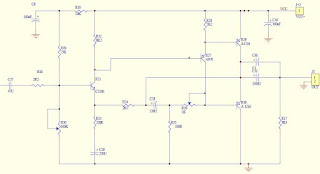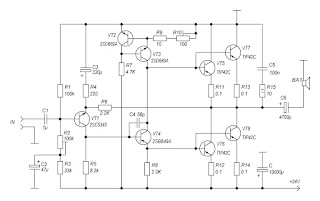The JLH Gateway to Class-A :: 11
The P-N-P Pandemic !
The audio scene, just like the fickle fashion scene, is prone to trends and fads that surface with some regularity out of the blue. One such trend/fad that gained some traction around 2015 or so was the 'P-N-P Fever' -- every (not exactly true...but still!) JLH fan and DIYer was swearing by the 'sound' of a JLH Classic implementation with PNP transistors in the output. And the Chinese kit retailers made good money out of old stock devices or fakes or whatever. Their lack of knowledge of English stood them in good stead, as nobody expected an instruction manual or even a circuit diagram-- it was just a PCB and some parts and sometimes even a fairly good cabinet and some average heatsinks -- but all bundled at an unbeatably low price! In all honesty, I must admit that some kits with old Sanken and other respected brand 'audio transistors' offered good value for money for the hobbyist who knew his ropes well.
But the fad took off and even the 'purists' who swear by quality parts and devices ordered the stuff in loads, and the discussion threads were hot with one mod or other that 'did the magic'. To me it appeared that it was just a practical side-step done by the kit makers, as once the NPN devices were bundled with the JLH 1969 kits, they were left with all those complementary PNP devices. (Usually these are sold in pairs, as we all know.) Some clever guy had this 'Eureka' moment and he prepared a PNP kit, and that opened the floodgates. Truth be told, we had the same problem here in my personal circle, as we too had a selection of PNP devices (most of them rare Sanken 'biscuit'audio transistors, and old TO-3 devices) and we were planning to build a few JLH PNP modules using them, when the 'trend' hit us.
To PNP, or not !
Whatever the cause or its effect, the PNP fever spread like covid and almost everybody we knew who had built a classic JLH was on the side building one more with PNP outputs! For us serious hobbyists, the important path we must explore is what it did to the 'classic sound' of the JLH 1969. All sorts of theories were being advanced to justify the apparent superiority of the PNP devices. At one time I was afraid it was going to be a brand new slanging match like the old ones we had about 'valve versus solid-state', 'bipolar versus MOS' and such like -- "the sound of electrons versus the sound of holes".
Be that as it may, here we have a selection of PNP output circuits which have given good results according to the builders. As always, there is nothing like "hearing is believing", and I assume the intrepid hobbyist will be only happy to build, listen and evaluate. So, full steam ahead sailing the PNP wave!
Many hobbyists bought the Zero Zone kits for 'modding' and experimenting. Here is one such popular mod, with a floating supply (after the 'sublimed JLH' design), which reportedly gave good fidelity and lowered power rail ripple.
The floating supply idea was popular with those who turned to good quality SMPS for powering the JLH amplifier. Again, a mod that I would recommend for the single rail classic JLH amplifier.
















Comments
Post a Comment